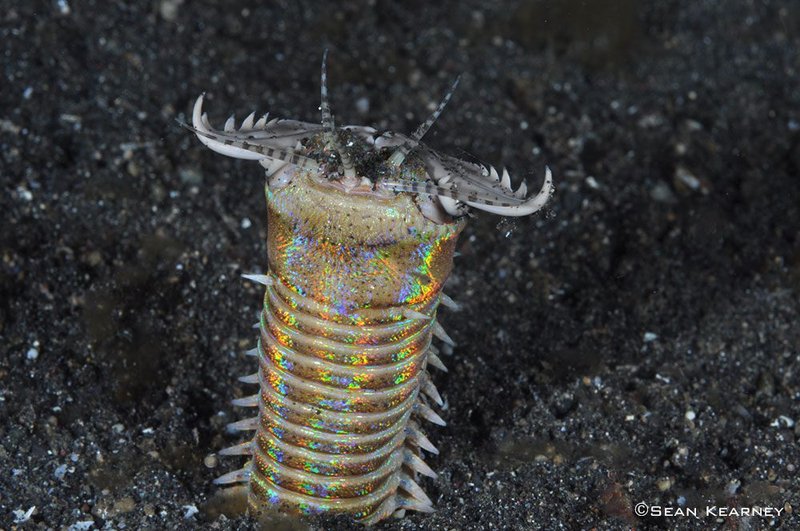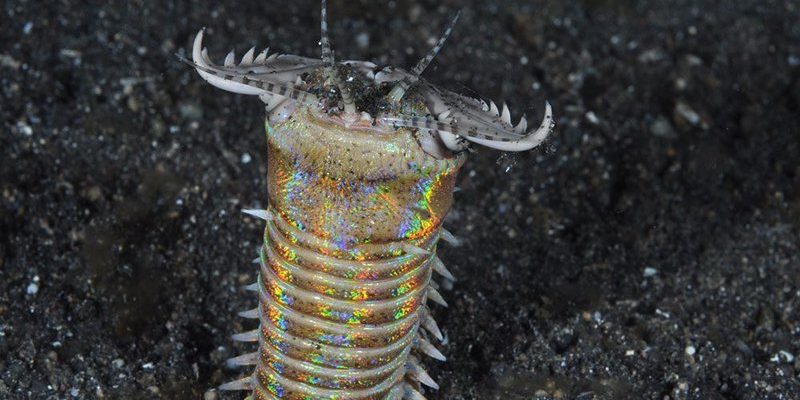
What is a Bobbit Worm?
Before we get into their feeding habits, let’s clarify what a Bobbit worm actually is. Scientifically known as *Eunice aphroditois*, this worm can grow up to 10 feet long! It’s usually found buried in sandy or muddy substrates in tropical and subtropical oceans worldwide. The worm has a segmented body, often displaying vibrant colors, and its head is equipped with sharp, fang-like jaws that make it an effective predator.
Bobbit worms are not your average worm. They can remain hidden under the sand, extending only their head and jaws to ambush unsuspecting prey. Think of them as the ultimate hide-and-seek champions of the sea! Their remarkable ability to blend into their environment helps them avoid larger predators while they wait for the right moment to strike.
Feeding in the Wild
In their natural habitat, Bobbit worms display a unique set of feeding habits. They’re known as **ambush predators**, meaning they essentially wait for food to come to them rather than actively hunting down prey. This behavior is crucial for their survival and success in the wild. When a fish or crustacean swims close enough, the Bobbit worm springs into action.
Here’s how the process generally unfolds:
- Camouflage: The worm blends seamlessly into the ocean floor, making it nearly invisible to prey.
- Strike: When prey approaches, the worm extends its powerful jaws and quickly snatches it up, often with little warning.
- Consumption: Once captured, the worm can quickly consume its meal, using its jaws to tear apart the soft-bodied prey.
Bobbit worms primarily feast on fish, crustaceans, and even smaller worms. This opportunistic feeding strategy allows them to thrive in diverse environments. You might be wondering how they manage to catch prey that often swims rapidly away. The answer lies in their speed and precision, as well as the sheer surprise they can inflict on unsuspecting victims.
Feeding in Captivity
When it comes to captivity, Bobbit worms often adapt their feeding habits. In aquarium settings, the dynamics change quite a bit. While they still retain some of their natural instincts, several factors can influence their feeding behavior.
First off, in a tank, Bobbit worms typically don’t have the same level of stimulation or challenges they would face in the wild. This might lead them to be less active or even reclusive, as the excitement of ambushing prey is diminished in a controlled environment. Here’s what feeding looks like in captivity:
- Diet Variety: In captivity, worm keepers often provide a varied diet that includes frozen shrimp, fish, and specialized worm food. This ensures the Bobbit worm gets the nutrition it needs.
- Feeding Method: Instead of waiting for prey to come close, some aquarists might actively place food near the worm to encourage feeding. This proactive approach can help ensure the worm eats regularly.
- Behavior Changes: Many Bobbit worms in captivity become somewhat lazy. They might not exhibit the same aggressive hunting behavior they display in the wild, as their environment lacks the natural stimuli that trigger those instincts.
While setting up an aquarium for a Bobbit worm can seem straightforward, the nuances of their feeding habits in captivity require careful attention. This means that if you buy one, you must be prepared to guide its diet actively.
Comparison of Feeding Habits
Now that we’ve explored both wild and captive feeding habits, let’s compare them side by side. Here’s a closer look at the key differences:
| Aspect | Wild | Captivity |
|---|---|---|
| Feeding Style | Ambush predator, waiting for prey to come close | Often encouraged through provided food items |
| Diet | Varied, largely based on available prey | Supplemented with artificial foods and frozen options |
| Prey Interaction | Active, aggressive hunting behavior | Less aggressive, often complacent |
| Environment | Variable, complex ecosystem | Controlled, often less stimulating |
This comparison highlights the stark contrast between their feeding behaviors in the wild and in captivity. While Bobbit worms are highly effective hunters in their natural habitat, their captivity can lead to a significant shift in how they approach feeding.
Challenges in Captivity
Keeping Bobbit worms in captivity can be rewarding, but it comes with its challenges, especially regarding feeding habits. Here are a few issues you might encounter:
1. **Dietary Needs**: Ensuring they receive a balanced diet can be tricky. Bobbit worms are opportunistic feeders, and if the diet lacks variety, they might not get the nutrients they require.
2. **Motivation to Feed**: Sometimes, captive worms may not exhibit a drive to hunt. This can lead to them ignoring food, which is frustrating for owners trying to maintain their health.
3. **Aquarium Conditions**: Maintaining the right conditions in a tank is critical. Improper conditions, such as temperature or water quality, can negatively affect feeding behavior and overall well-being.
These challenges underscore why it’s essential for potential Bobbit worm owners to do their homework. Understanding their feeding habits and environment can help you create a suitable habitat where they can thrive.
The Importance of Mimicking Natural Behaviors
While feeding Bobbit worms in captivity can differ from their natural instincts, it’s crucial to create an environment that encourages natural behavior. Here are some tips on how to mimic their wild feeding habits:
- Provide Hiding Spots: Create places in the tank where your Bobbit worm can hide. This can stimulate their natural instinct to ambush.
- Introduce Variety: Regularly change their diet and introduce different food types. This keeps them engaged and mimics the diverse environments in the wild.
- Monitor Behavior: Keep an eye on how they respond to food offerings. If they seem less interested, experiment with different feeding styles or foods.
By understanding and respecting their natural feeding habits, we can help these incredible creatures live healthier lives in captivity, even if the environment is far different from their natural home.
The Bobbit worm is a unique creature that showcases the remarkable diversity of marine life. Understanding its feeding habits in both the wild and captivity reveals just how adaptable these worms can be. While they’re formidable predators in their natural habitat, their behavior can change significantly once they find themselves in an aquarium setting.
Whether you’re fascinated by their ambush tactics or you’re thinking about keeping one as a pet, knowing the ins and outs of their feeding habits is crucial. By bridging the gap between wild and captive environments, we can ensure these incredible worms lead healthy, fulfilling lives, revealing even more about the wonders of the ocean.

